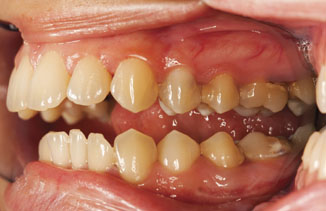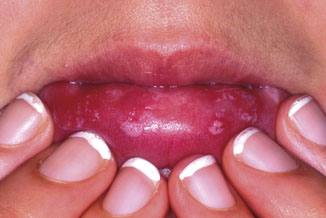Clinical

Could you identify oral cancer?
In Clinical
Let’s get clinical. Follow the links below to find out more about the latest clinical insight in community pharmacy.Bookmark
Record learning outcomes
With a significant rise in the number of cases over recent years, it is highly likely that pharmacists will encounter customers with oral cancer, says Karen Coates of the Oral Health Foundation.
Â
Learning objectives
After reading this feature you should be able to:
• Recognise the signs and symptoms of oral cancer
• Explain the lifestyle factors that may increase the risk of oral cancer
• Offer advice that could help to reduce the number of cases of this type of cancer.
Â
 In the early 1980s, 1,912 cases of oral cancer were reported in the UK, with a substantial difference between cases reported in men (1,237) and women (675). Over the next decade (1984-1993), the number of cases reported rose by 84 per cent to 3,522.1
In the early 1980s, 1,912 cases of oral cancer were reported in the UK, with a substantial difference between cases reported in men (1,237) and women (675). Over the next decade (1984-1993), the number of cases reported rose by 84 per cent to 3,522.1
Sadly, the number of people diagnosed with mouth cancer continues to grow. According to the most recent figures from Cancer Research UK, there were 11,449 cases of oral cancer in 2014, with roughly twice as many cases in men (7,900) than women (3,500).
While the disease is still heavily weighted towards men, more women are developing oral cancer than ever before and, despite there being a slight shift in the number of younger people diagnosed with oral cancer, it is still a disease that affects predominantly the over-40s. Like many other cancers, oral cancer is linked with social inequality.
During the two decades studied, oral cancer cases have increased by 115.5 per cent. This is more than 10 times the reported increase in all types of cancer in the UK in the same period (13.5 per cent). Overall, the increase over the past 30 years has almost tripled (297 per cent).
Much of the increase in oral cancer incidence can be attributed to the major lifestyle factors that are related to oral cancer:
• Smoking
• Excessive alcohol consumption
• The human papillomavirus infection transmitted via oral sex.
Survival rates have seen no improvement over the same period, as many cases are diagnosed too late to be treated effectively. Early diagnosis and resulting treatment can improve a person’s chances of survival to around 90 per cent, compared to 50 per cent in late diagnosis – so it is important pharmacy teams have a comprehensive understanding of oral cancer in relation to risk factors and symptoms.
Â
Quick quiz – do you know?
1. Can you identify three signs and symptoms of oral cancer?
2. Which HPV sub-types are associated with oral cancer and what other common cancer can these sub-types cause?
3. What are the chances of a person’s survival based on a ‘late’ and an ‘early’ diagnosis of mouth cancer?
4. How much does smoking increase the likelihood of someone developing oral cancer?
See end of article for answers
Â
Recognising the symptoms
A recent survey of the British public regarding who they would go to when suffering with a non-healing mouth ulcer (one of the early warning signs of oral cancer) shows that one in 10 are more likely to approach their pharmacist for advice before consulting a doctor or dentist.
Many members of the public see their pharmacist as a trustworthy, highly accessible and impartial expert who they can get advice from as and when they need it, whereas visiting their dentist or doctor requires a longer process involving making appointments and possibly having to take time off work.
If any of the following symptoms of oral cancer are identified, patients should be advised that an urgent referral to a specialist is needed. The most prominent and easily identifiable symptom of oral cancer is an ulcer with a raised edge, which may discharge blood. These ulcers are not always painful and may even have been dismissed or forgotten about by the patient.
Patients should be asked how long they have had an ulcer as this is an excellent clue as to the possibility of it being a sign of oral cancer. Anything over three weeks should ring alarm bells and the patient should be referred to a specialist urgently. However, most cases of oral cancer do not present as ulcers in their early stages.
Recent studies2 have identified that many oral cancers in their early stages manifest as irregularities in the oral cavity, usually in the form of red or white patches that can have an irregular surface texture or appearance.
Again, further questioning is vital in informing any referrals. If a patient says he/she has had these symptoms for some time, this can severely affect the chances of survival if it turns out to be oral cancer.
Other symptoms of oral cancer include unusual lumps or swellings in the mouth or the head and neck area. If swelling occurs in the neck area, then it suggests enlarged lymph nodes – a common symptom or oral cancer. These lumps are usually persistent and slowly increase in size over time.
It may also be possible to identify further oral cancer symptoms such as weight loss, unexplained numbness in the mouth, difficulty moving the jaw, speech problems due to swelling of the tongue, persistent pain in the mouth, difficulty swallowing, persistent dry mouth and persistent unexplained halitosis.
Contributing risk factors
Although oral cancer can affect anybody, it is estimated that around 91 per cent of all diagnoses are linked to lifestyle choices.
Smoking
Smoking is believed to be the leading cause of oral cancer in the UK and roughly two in every three oral cancer cases are thought to be the result of smoking and tobacco use. Smokers are estimated to be three times more likely than non-smokers to develop oral cancer.
Pharmacy teams should use every opportunity to find out if patients who smoke are planning to stop smoking and to offer advice on smoking cessation services.
Alcohol
Continued excessive alcohol consumption is associated with roughly a third of oral cancer cases. The Government’s guidelines state that there is no safe level of alcohol consumption. Unit guidelines are now the same for men and women and both are advised not to regularly drink more than 14 units per week.
Patients are widely regarded to under-report their alcohol intake, so pharmacy staff should consider what their patients tell them and, where relevant, offer advice on ‘safe’ levels of alcohol consumption.

Human papillomavirus (HPV)
The human papillomavirus (HPV) is an extremely common virus that is sexually transmitted. Almost every sexually-active person is likely to contract a form of HPV at some time in their lives. There are nearly 200 different strains of HPV, most of which are harmless and do not cause cancer, yet it is predicted that HPV could soon become the leading cause of oral cancer, overtaking the more traditionally taught causes such as smoking.
The two sub-types of HPV that are associated with oral cancer are types 16 and 18 (also responsible for cervical cancer in females). In the UK, there is currently a HPV vaccination programme for school age females, but this has not been extended to include males.
The fastest growing demographic of oral cancer patients in the UK are otherwise healthy non-smokers in the 25-50 year age range, which suggests that HPV spread through sexual activity is the major lifestyle factor that is contributing to this increase.
HPV of the oral cavity is spread through oral sex, which can make it difficult approaching patients due to the sensitivity of the situation. By understanding the risk posed by HPV and checking for the major signs and symptoms at an early stage, pharmacy teams can help to alert patients in this demographic to the risk.
Diet
It is estimated that up to half of all mouth cancer cases are partly contributed to by poor diet. Non-starchy vegetables and fruits (not salted or pickled) and foods containing carotenoids have been proven to reduce oral cancer risk.
The risk of oral cancer is lower in people with the highest intake of the following foods (compared to those with the lowest intake):
• Fruit: 48 per cent lower risk
• Vegetables: 34 per cent lower risk
• Vitamin C supplements: 24 per cent lower risk (versus never-users)
• Calcium supplements: 36 per cent lower risk (versus never-users)
• Caffeinated coffee: 39 per cent lower risk in four cups/day (versus non-drinkers)
• Green tea: 20 per cent lower risk.
Conclusion
Recent figures show that less than half the UK population are able to identify the main symptoms of mouth cancer and even less are aware of the major causes of the disease. By understanding the signs, symptoms and risk factors associated with oral cancer, community pharmacists and their teams can dramatically improve patients’ prognosis.
One area in which pharmacists can have an impact is through patient education by displaying leaflets and posters or referring to online information. Patients should also be encouraged to self-examine at home and be aware of any changes in the mouth. Discussing early warning signs and risk factors to help develop patients’ understanding of oral cancer is the first step in transforming public awareness of the disease.
If irregularities are identified, a patient should be referred to a specialist urgently. All effort should be made not to alarm the patient so, in the initial stages, using language such as “getting a second†opinion can be very helpful.
It is difficult to predict future oral cancer patterns. Taking into account historic trends, the incidence of oral cancer looks likely to continue to increase but it will be interesting to see what affect the smoking ban and overall reduction in the number of people smoking in the UK has on oral cancer cases. What we may see is HPV-related cases continuing to rise, overtaking smoking as the leading cause of oral cancer.
Pharmacists will undoubtedly play a key part in helping to identify and improve the possible outcomes of patients with oral cancer due to their position on the front-line of patient services and their opportunities to communicate with patients.
Â
Common oral health problems
Bad breath
Bad breath can affect everyone from time to time, with causes ranging from smoking to food and drink or an infection in the mouth. Persistent bad breath is usually caused by gases released from dental plaque and can be effectively managed by good oral care, including using interdental brushes and mouthwash, and taking care to brush the tongue during toothbrushing.
Chewing sugar-free gum between meals may also be effective. People with dry mouth or with dentures are also more prone to bad breath. Dentures should be brushed to remove food debris before soaking in an effervescent denture cleaner or soaking solution and brushing again.
Teething
Milk teeth usually erupt during the first six to 12 months of a baby’s life. While some teeth emerge with no apparent discomfort, teething can be a painful process, making a baby irritable, grizzly and clingy. Dribbling, flushed cheeks and gnawing are also signs of teething.
Teething rings give a baby something to chew on, which may ease the discomfort and provide a distraction from any pain. Some teething rings can be cooled first in the fridge, which may help to soothe a baby’s gums. Sugar-free teething gel can be rubbed on the gums of babies over four months old. These often contain a mild local anaesthetic, which helps to numb any pain or discomfort.
Cold sores
Cold sores are caused by the type one strain of the herpes simplex virus (HSV1), which is usually caught in childhood. The virus lives in the roots of the nerves until triggered, usually by illness, stress, sunlight or cold. A cold sore starts with a tingling sensation around the lip that develops into a small, painful cluster of blisters, which may burst, leaving a red, sore, contagious area.
An antiviral cream containing aciclovir or penciclovir can speed up healing, especially when applied at the tingling stage. Special patches are also available that quicken healing and reduce the risk of the infection spreading. Good hand hygiene and avoiding touching the lesions are essential to avoid transmission, while applying a sunscreen lip balm may reduce outbreaks.
Mouth ulcers
Mouth ulcers may be caused by oral trauma or poorly fitting dentures or they may be triggered by stress or certain foods in individuals with a genetic predisposition. Most aphthous ulcers heal within 10-14 days and various OTC topical products are available to help manage the pain, including topical analgesics and anaesthetics. A mouth ulcer that has not healed within three weeks could be a sign of mouth cancer (see main feature) and requires urgent referral.

Toothache
When toothache occurs, customers should visit a dentist, but in the meantime can be advised to dab clove oil on the affected area to relieve the pain or take oral analgesics. Clove oil has been long used for the relief of pain caused by tooth decay and cavities as a result of its natural anaesthetic and antibacterial properties.
Denture pain
If dentures fit properly, customers shouldn’t need to use denture fixative, but if the jawbone has shrunk significantly since the dentures were made, adhesive may be needed to help keep the dentures in place. While dentures are pretty tough, they are not indestructable and are softer than natural teeth. Not looking after them can effect how they fit.
Anyone with a complete set of dentures should continue to see their dentist regularly because if poorly fitting or worn dentures aren’t replaced, they can cause discomfort and lead to mouth sores, infections, or problems eating and speaking.
Dry mouth (xerostomia)
Dry mouth disrupts the flow of saliva through the mouth causing unpleasant symptoms, including difficulty swallowing, coughing, cracked lips, a choking sensation, difficulty eating and talking, and waking during the night. It usually occurs as a side-effect of certain medications (e.g. antihistamines, antidepressants, some beta-blockers, antihypertensives and diuretics) and can contribute to other oral health problems including tooth decay, gum disease and bad breath.
A range of products is available for dry mouth sufferers including specially formulated toothpastes and rinses, as well as lubricating sprays, gels, tablets and gum. Sufferers of dry mouth should avoid oral care products containing sodium lauryl sulphate, which can irritate the mucosa and exacerbate symptoms.
Tooth sensitivity
Tooth sensitivity occurs when tooth dentine becomes exposed by enamel wear or gum recession. The dentine contains tubules that lead directly to the nerve and when exposed to pressures such as heat or cold can cause pain and discomfort.
Specially formulated toothpastes are available that manage sensitivity, either by blocking the tubules or building a protective layer over vulnerable areas of the teeth, while soft-bristled toothbrushes are designed to be gentle on teeth and gums. Consumer research shows 71 per cent of daily toothpaste users have sensitive teeth, yet only one in three buy a sensitive toothpaste.
Answers to test questions
1. The following are signs and symptoms of oral cancer:
• Ulcers that last for longer than three weeks
• Irregular red or white patches in the mouth
• Unusual lumps or swellings in the mouth or head and neck area
• Weight loss
• Unexplained numbness in the mouth
• Difficulty moving the jaw
• Speech problems due to swelling of the tongue
• Persistent pain in the mouth
• Difficulty swallowing
• Persistent dry mouth
• Persistent unexplained halitosis.
2. Sub-types 16 and 18 are associated with oral cancer and are also associated with cervical cancer
3. Early diagnosis and resulting treatment can improve a person’s chances of survival to around 90 per cent compared to 50 per cent in late diagnosis
4. Smokers are estimated to be three times more likely than non-smokers to develop oral cancer.
It is predicted that HPV could soon become the leading cause of oral cancer
